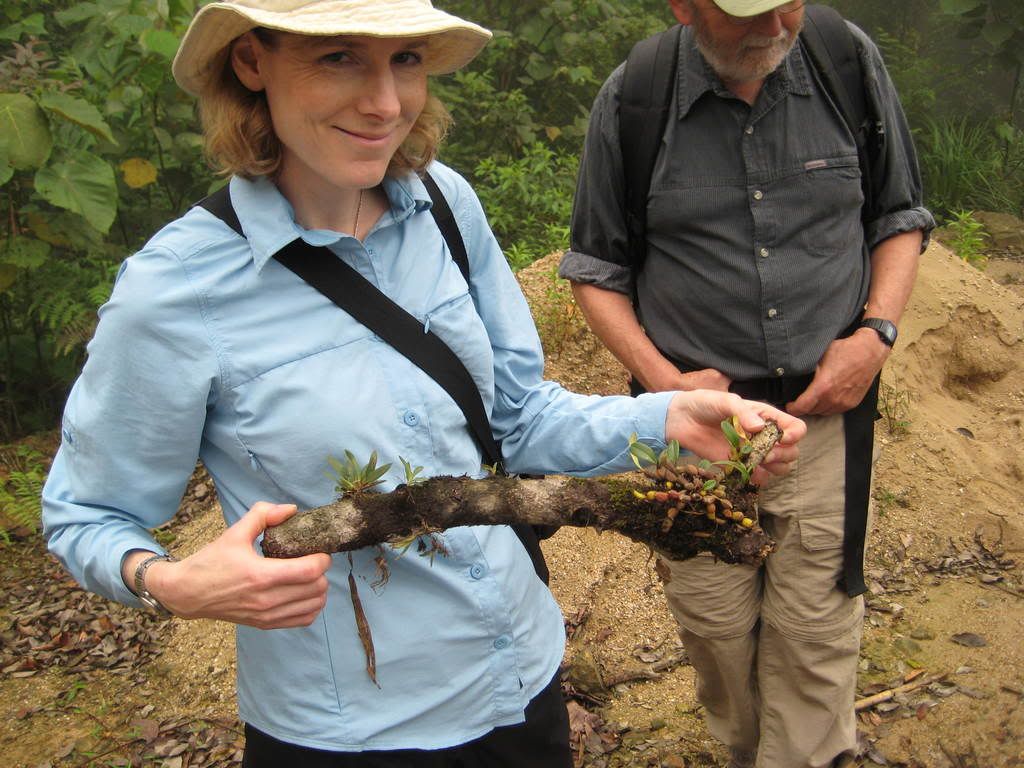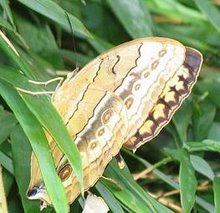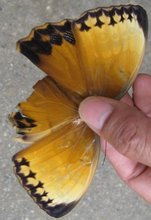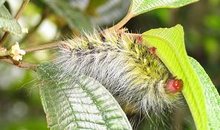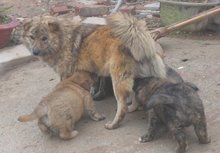Sunday, May 27, 2007
I'm Back, I'm Home
I've uploaded some of my photos from my Vietnam trip to Photobucket. There are a lot of ads, but this site allows me to share my photos with anyone for free. If you click on the images you'll see them full size. Please let me know what you think!
Thursday, May 17, 2007
Winners and a New Challenge with a Prize
1. Cambodia, Laos and China
2. Invertebrates--no backbones
3. Charles (or Charlie) M. Russell
Good work!
All About Butterflies and Another Quiz with a Prize
Vu Van Lien is keeping track of what is happening to the butterflies in Tam Dao National Park because they are an indicator species, just like the macro invertebrates we studied in the fall.
The first two people to post correct answers to all three questions win a special prize. There are three questions, but the third one is down lower in this post.
Question one: what is an indicator species?
Question two: why should we study indicator species? In other words, what types of important information do we learn from what happens to them?
Here are some interesting facts I’ve learned about butterflies:
You can safely hold a butterfly or moth by gently holding its body right below the head—one finger on top, one on the bottom. See photo of this.
If you want to see a butterfly, look during the hours of 9 am to 4 pm when they are the most active. If you look carefully you will also see many small moths, which shows that not all moths fly at night.
Butterflies sleep in trees and love the sun.
Only four species of butterfly her in Tam Dao fly in the fog, which we’ve had every day.
Forest butterflies are darker than open field or lowland butterflies.
The butterfly’s antenna can sense mates and food plants.
Some caterpillars eat flowers rather than leaves.
In colder climates some butterflies and caterpillars can hibernate for up to a year in bark of a tree, branches, and even underground.
I had read this fact but was not sure it was true until Lien confirmed it—while in the chrysalis or cocoon, the caterpillar turns completely into liquid to reform into a butterfly. This is amazing to me!
Question number 3: Name one common butterfly in the Spokane area that is not a painted lady or a monarch. Make sure the spelling is correct. You may need to do some research—perhaps Dianne has a book in her library. I believe that I have a book of insects on the shelf near the classroom door and robin might have some books as well. As a last resort, with parent permission you could do an internet search at home using the key words Spokane butterfly local. If these words don’t help, you can ask your parents or Robin or Joy for other key words to search.
The Winners
1. India
2. 300-500
3. Mulberry trees do not grow in many places in the United States, and silk worms need them to eat. Interestingly, they do grow in Las Vegas, and many teachers have them in their classrooms!
You two have won some special prizes from Vietnam when I return.
Great work!
Another Foggy Day
I have been taking many photos of the dogs of Tam Dao. It is difficult for me to understand which ones are for food and which are pets.
I am not sure if I have seen a house without a dog hanging around the front. Dogs are everywhere--they bark at you, and follow you for a few feet, but none attack or growl.
I do not believe most are treated like what we call a "pet." They seem fed enough, and relatively healthy, but most will not come up to me for petting, even when I call them. There are fewer cats around, and all but "my buddy" in the internet cafe run from me as soon as I look at them. I am sad to say that the Vietnamese do eat cat, too. However, the people of Tam Dao are, for the most part, very poor and thin--I have not seen one overweight person here.
Vietnam is a very safe place. I can pretty much travel anywhere I want without fear of being mugged or bothered in any way. The people here work very hard and take care of one another.
Today's quiz also provides a prize to the first two people who answer all three questions correctly:
1. List the three countries that Vietnam borders. You must spell them correctly.
2. Are butterflies invertebrates or vertebrates? Why?
3. What is the name of the artist in Montana whose studio you will visit on our trip next week? You must spell his name correctly.
Take care! I miss all of you and can't wait to return, but I am having fun here!
Wednesday, May 16, 2007
Greetings
To get to the quiz, there were three correct answers, but one person didn't sign their name. The correct answer was:
A. butterflyB. butterflyC. mothD. butterfly
I think, however, that it was really hard to tell from the small photos I posted. I can't make them larger from where I am, but I can show you much better ones when I return.
So Cade and Sierra (or Sienna, sorry I didn't look carefully--you let me know) got it right and will get an extra special present from Vietnam when I return (everyone will get something).
The duck eggs look exactly like chicken eggs but larger. The yolk is larger, too, but they taste the same.
Every morning a man on a motorcycle drives around the village with a loudspeaker blaring, saying in Vietnamese "Fresh bread, come get fresh bread." The hotel where I'm staying buys the loaves there for 20 cents a piece. They are sort of like large hotdog buns but crispy on the outside and soft on the inside.
Today I hiked up 1200 steps to a tower looking for butterflies, then back down.
New Quiz: Another prize will be rewarded to the first two people who answer all of the questions correctly. You will find the answers in your butterfly book I made, in one of the stories (you'll have to figure out which one).
1. According to the article, silk is produced mainly in China, Japan, Italy and __________.
2. One female silkworm moth may lay as many as _______ eggs.
3. Why is it difficult to raise/farm silkworms in the United States? __________________
Today we caught a HUGE butterfly called "Jungle Queen." I will try to post a photo of it.
Last night, while walking back to the hotel from the computer internet cafe, I ran into some people who were catching snakes and frogs. We did not figure out why--perhaps for food. The Vietnamese people who live in Tam Dao are generally very poor. The music teacher at the local school earns 30 dollars a month--that's one dollar a day. Most teachers in the city earn 40-50 dollars a month. There are no grocery stores here, mail is not delivered, no newspapers, and I have not seen one police person.
I enjoyed reading all of your posts about punishment at Vietnam schools. My feeling is that there is less behavior problems in Vietnam schools, but I really have no idea.
Tuesday, May 15, 2007
Butterflies--And a Chance to Win a Prize!
6:30 am: wake up, shower, get dressed, tidy up room
7:30 am: breakfast of hard boiled 2 duck eggs and a baguette (this is a small loaf of French bread), tea or coffee
9:30 am: Walk a transect. My reading students might remember that a transect is an area of land that is marked on a chart. In each transect there are regions—usually 9. We walk the transect very slowly and look for butterflies. Mostly we see these white butterflies that have black spots. They are very common here and in the United States. We call them cabbage butterflies because they eat cabbage plants. I bet you’ve seen them around!
1:30 pm: Lunch. Lunch is a large meal in Vietnam, much larger than breakfast and about the same size as dinner. There are two of us who do not eat meat so luckily there are lots of things for us to eat, which include boiled cabbage, chayote, eggplant, and French Fries. They do not seem to have drinks of any sort with their meals—no water, pop, or milk (actually I have not seen any milk since I’ve been in Vietnam).
2:30 pm: walk a different transect.
5:00 pm: rest (sometimes I sleep, sometimes I read—I have been reading The Thief Lord in preparation for book club).
6:30: dinner. Many different dishes, always rice is served second to last (not with the meal). Fruit (like bananas, mangoes or a wonderful fruit called dragon fruit) is served at the very end. This is our only dessert. No cookies, cakes, or ice cream.
7:30: walk to computer/internet café and wait, wait, wait for pages to load. Sometimes it takes me two hours to post one passage like this one. No joke!
10:30 pm: read and bedtime.
For the quiz: I have posted photos of four butterflies and moths. To win a prize, look carefully at each photo and tell me if it is a photo of a butterfly or a moth. I will give you a hint: there is at least one of each, and here is a reminder of the differences between the two: moths are usually fuzzier, when they land they usually lay their wings flat, and they have straight antennas. Butterflies usually (not always) have clubbed antenna, when they land they hold their wings up above their bodies, and they usually (but not always) fly during the day while moths usually (but again not always) fly during the night. Be sure to label your answers like this: A. Moth B. Butterfly C. Moth (all of these answers are made up).
Monday, May 14, 2007
Learning about Vietnam: Schools in Vietnam
It turns out that some schools are so overcrowded that they have to go to school on Saturdays. This is especially true in the large cities.
The assistant researcher whom I’m working with, Viet, is a teacher so I asked him many questions about Vietnam’s schools. I thought you might enjoy some of these facts:
It is required that all children go to school up until grade 9. If they want to continue to go to school after grade 9 (age 14 and 15) their parents have to pay for it.- Elementary students go to school from 7 am to 10 am. School ends, and most students go home for lunch, rest, play or work. They have to return to school the same day from 1:30-4:30 pm.
- In the country schools (rural—remember that word from earlier in the year), students go home for lunch—all children do (and they have to walk or parents have to pick them up—there are no busses). Lunch is not offered.
- In the city schools lunch is offered but if your family cannot afford to pay for your lunch you have to go home. There is no money to help poor families.
- Elementary teachers have classes of 30 to 40 students.
If a child misbehaves the teacher can strike him/her on the cheek, hit him/her with a ruler, or pinch the child’s ear. This is legal, normal, and expected.
So here are today’s questions. Pick one to copy, paste, and answer. Don’t forget your name.
1. Do you think that there are fewer behavior problems in Vietnamese schools than compared to United States schools, because of how teachers can punish students? Explain your answer.
2. In United States public schools, poor children can get free or cheaper school lunches. The taxes your parents pay help pay for this program. But in Vietnam poor kids go home for lunch. Which system do you think is better? Do you think it is fair that the taxes your parents have to pay go toward paying for poor kids’ lunches? Explain your answer.
3. In the United States, schooling is free until grade 12, when you hopefully graduate and get your high school diploma. What if we had a system like Vietnam’s, where only up until grade 9 is it free. How would this change our world? How would things be different in the United States? Explain your answer.
I can’t wait to read what you write. Today I had duck eggs for breakfast!
Sunday, May 13, 2007
Day 1 in Tam Dao
Hi Cade and Elizabeth, thanks for writing! I learned, Cade, that the colder the habitat the longer life a butterfly will have. However, most butterflies only live about the same length as our painted ladies. And, you might be surprised to learn that there are painted ladies here in Vietnam!
After staying one night in Hanoi, I met up with my team members and the lead scientist, Vu Van Lien, and we drove to Tam Dao National Park, where I am now and will spend the rest of my time in Vietnam. Last night we had a monsoon.
Today (Sunday, May 12th) Vu Van Lien explained to us what we will be doing for the rest of the week. I learned some interesting facts about butterflies from him. Here are just a few:
Years ago someone paid $100,000 dollars (that’s American dollars) for a very rare butterfly specimen found in Vietnam. Now people raise and sell this particular species of butterfly for $100.
Female butterflies don’t spend much time looking for food. Instead, they get most of their nutrients and energy from the male butterflies, who do spend most of their time looking for nectar. The females spend their time looking for plants that the eggs they lay can eat when they hatch (yes hatch—they eggs hatch, the caterpillars ____________).
Some female butterflies lay their eggs on the wrong plants. When their eggs hatch, the caterpillars die from lack of food.
Not all caterpillars eat leaves—some eat flowers.
Butterflies are most active during the hours of 9 am and 4 pm. After that many of them rest.
Question number 1: Please look up “monsoon” in a dictionary and post what it is for others to read. You could also look it up in Encarta.
Question number 2: Is there anything you collect that you might pay a lot of money for? Share!
Question number 3: Birds are just one of many different butterfly predators (in other words, birds are one type of animal that eats butterflies). Can you think of any other kinds of animals that eat butterflies? Take a guess!
Don’t forget to type your name into your response so that I know who wrote each comment!
P.S. I would like to upload more photographs--I've taken over 200 so far, but I have a really slow connection, so slow that it took me 30 minutes to open this account and post!
Friday, May 11, 2007
I've Arrived--Day 1
I arrived last night and was given an upgraded room. The exchange rate currently is 16,004 Dong for 1 U.S. Dollar. I exchanged 200 dollars, so how much in Dong did I receive?
It is muggy here. Look that word up and share with your peers what that means. I now have curly hair. I'll take a photo of myself later and post it.
Today I'll take a bus ride out to Tam Dao National Park, where I'll spend my time working. I can't wait!
Thank you for all the comments. I really have enjoyed reading all of them. Keep posting and asking me questions. I do not plan on trying dog meat, so don't worry. I have seen a few dogs around, but they seem to be pets in good shape. I hope to see a cat or two as well. From my hotel room I can hear many different sounds, but my favorites are some tropical birds that I cannot see. I'll try to get more photos.
Please post an answer to at least one of my questions above. If you see some typos in this post it's because I'm using a different keyboard and my hand has gone to sleep.
Rachel
Wednesday, May 9, 2007
I'm Off
Asiana Air
I like the television screens in the backs of the chairs!
Question number 1: What is the longest flight you’ve ever been on? How did you stay entertained?
Question number 2: What should I make sure to do while in Vietnam? Give me some ideas!
Question number 3: What should I make sure not to do while in Vietnam?
I can’t wait to hear from you!
Monday, May 7, 2007
Assignment Number One
Use the book I made for you, Butterflies: Facts and Drawings, to answer the following questions by posting your answers to this blog. Copy and paste the questions into your post, then answer them (be sure to include your first name in your answer so I know who has responded). All of the questions are “Right There” questions, so they will be easy to find. In fact, the answers to all three questions are on the same page!
1. What are the three main body parts of a butterfly?
2. Thousands of what cover a butterfly’s wing surface?
3. How many stages of metamorphosis does a butterfly go through before they are full grown?
Sunday, May 6, 2007
We Have Butterflies!
Last Monday morning I entered my classroom at 7:30 am and checked the chrysalises, who all seemed to be in the exact position as I left them on Friday. By 8:15 am, however, when my students began entering the classroom, three butterflies had emerged in the largest of our four habitats. By the end of the day, we have seven butterflies. By the end of the week, we had fifteen. Some of my students were lucky enough to watch a butterfly emerge, as was I. For me the most interesting transformation was watching the wrinkled, soft small wings fill with liquid and grow to their full size. Here are answers to some questions asked by my students:
What is the difference between a chrysalis and a cocoon? While both butterflies and moths go through a metamorphosis, they form different “coverings” during this process. A cocoon, made by moths and some other insects, is a protective coil of silk and sometimes leaves. Butterflies form a chrysalis, which is made of hardened skin.
What is the difference between a moth and a butterfly?
Moths tend to have fatter and fuzzier bodies, usually are nocturnal, and often have feathery, fuzzy antennae, and tend to rest with their wings down.- Butterflies tend to have straight antennae with rounded or clubbed tips; rest with their wings up above their bodies
Here is a nice web site that shows the difference between butterflies and moths.
Moth or Butterfly?
Butterfly Rainforest
My favorite moth is the sphinx moth. My husband and I used to watch them fly around in the summer evenings, around 10 pm, in Las Vegas, Nevada. They are so big that at first we thought they were hummingbirds. You can see some of them here:
How can you tell if a butterfly is a male or a female? Females have larger abdomens than males and males have claspers (found on the last segment on a butterflies’ body that are used to clasp onto a female butterfly during mating)
How long will our butterflies live? About two weeks. This is their natural life cycle.
Three Teachers--Jeff, Rachel and Beth
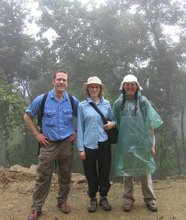
Red and Yellow
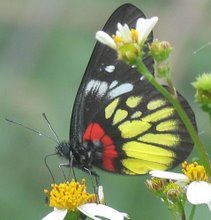
This one is beautiful and also quite common
Rare Green Butterfly
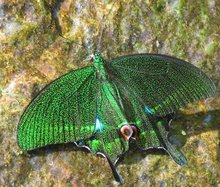
This one is drinking water from a waterfall we hiked to
Tam Dao Classroom

Yes, this is an actual classroom being used
Rachel at a Classroom Teacher's Desk in Tam Dao Primary and Secondary School
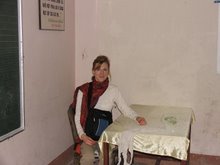
Yes, this is an actual teacher desk
Tam Dao was once a summer retreat for wealthy French families when France occupied Vietnam
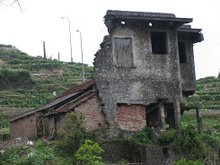
This is what's left of one French villa--there were over 400 here at one time, but were destroyed by the Vietnamese people in the 1950s
Hanoi Time
Hanoi |
